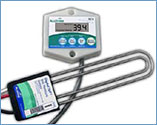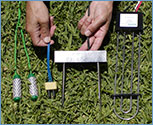Soil Moisture Sensors Save Water
IrriGATOR Newsletter — Spring 2013
We began research involving smart technologies in 2004 using soil moisture sensor systems (SMSs). The SMSs were add-on devices that connected to the existing irrigation timer. The system includes a sensor buried in the soil and a sensor controller wired to the timer to act as a disruption switch when the soil moisture exceeds a threshold. When disruption occurs, the soil is considered too wet for additional water and the entire irrigation cycle is bypassed. Since 2004, UF-IFAS has expanded SMS research to include multiple plot studies and residential cooperator studies. Though each study was designed to address specific research questions, the global objective was to determine if SMSs could reduce irrigation application compared to typical residential irrigation systems without sensor feedback (WOS).
The plot studies were conducted in Gainesville, FL and Citra, FL with sensors buried three inches deep and irrigation runtimes adjusted monthly. In Gainesville, the four SMSs selected for evaluation were commercially available at the time and programmed with thresholds near field capacity (FC) using manufacturer procedures. In Citra, two SMSs were tested at three different SWC thresholds: low (~50% FC), medium (~80% FC), and high (>=FC). All treatments were programmed to apply the same amount of irrigation per week except for non-irrigated plots that were used as a control for turfgrass quality. Turfgrass quality was rated on a 1 to 9 scale, with 1 representing dead grass and 9 representing excellent grass with minimum acceptable quality rating of 5.
Results from the plot studies during normal to wet weather conditions showed that SMSs significantly reduced irrigation application, 42 – 72%, without a reduction in turfgrass quality when compared to traditional residential irrigation systems with no sensor feedback. Even the non-irrigated treatments remained at the minimum acceptable rating. Conversely, during dry weather conditions, SMS-based treatments resulted in water savings ranging from -1 to 64%. The turfgrass quality sometimes declined for SMSs with settings at the lower limit. The non-irrigated plots always resulted in turfgrass quality below minimum acceptable levels and, in some cases, even death.
 Threshold settings were important in
sandy Florida soils with field capacities
around 7 to 11%. The medium thresholds
on the SMS-based treatments universally
resulted in good quality whereas the high
threshold treatments over-irrigated and
the low threshold resulted in poor to
unacceptable turfgrass quality during dry
weather conditions. Therefore, the
medium threshold settings appear to be adequate to balance
turfgrass quality and water conservation in Florida. However, the
irrigation frequency, run time, and threshold setting should be
carefully considered to ensure proper turfgrass health when under
sustained dry weather conditions.
Threshold settings were important in
sandy Florida soils with field capacities
around 7 to 11%. The medium thresholds
on the SMS-based treatments universally
resulted in good quality whereas the high
threshold treatments over-irrigated and
the low threshold resulted in poor to
unacceptable turfgrass quality during dry
weather conditions. Therefore, the
medium threshold settings appear to be adequate to balance
turfgrass quality and water conservation in Florida. However, the
irrigation frequency, run time, and threshold setting should be
carefully considered to ensure proper turfgrass health when under
sustained dry weather conditions.
After positive field results, a study was conducted to determine “real world” SMS performance in a residential setting. Twelve SMSs were installed at cooperating homes in Palm Harbor, FL with thresholds of 10%. The irrigation schedules were not adjusted for any treatment on any home resulting in the WOS treatment equating to actual homeowner practices.
 Results showed that homes with SMSs applied
65% less water than the comparison homes during
the mostly dry weather conditions. Despite savings,
no differences in turfgrass quality were detected
among treatments.
Results showed that homes with SMSs applied
65% less water than the comparison homes during
the mostly dry weather conditions. Despite savings,
no differences in turfgrass quality were detected
among treatments.
Furthermore, homes with SMSs averaged fewer irrigation events (2.3 times/month) than the total possible events under local watering restrictions (4 times/month). Therefore, SMSs could curb over-irrigation by regulating inappropriate timer scheduling.
Relevant Publications
The following publications were summarized to provide the feature story:
- Cardenas-Lailhacar, B., M. D. Dukes, and G. L. Miller. 2008. Sensor-based automation of irrigation on bermudagrass during wet weather conditions. J. of Irrigation and Drainage Engineering 134(2): 120–128.
- Cardenas-Lailhacar, B., M. D. Dukes, and G. L. Miller. 2010. Sensor-based automation of irrigation on bermudagrass during dry weather conditions. J. of Irrigation and Drainage Engineering 136(3): 161-223.
- Haley, M. B., M. D. Dukes. 2012. Validation of Landscape Irrigation Reduction with Soil Moisture Sensor Irrigation Controllers. J. of Irrigation and Drainage Engineering 138(2), 135–144.
- McCready, M. S., M. D. Dukes, and G. L. Miller. 2009. Water conservation potential of smart irrigation controllers on St. Augustinegrass. Agricultural Water Management 96(11): 1623–1632.

